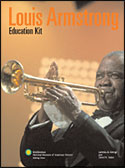As COVID-19 deaths spiked in 2020, Suzanne Firstenberg’s public art installation "In America: How could this happen…"
History Explorer Results (38)
Related Books (2)

Grade Range:
5-12
Resource Type(s):
Interactives & Media, Lessons & Activities
Duration:
100 minutes
Date Posted:
6/11/2012
This kit of guided listening activities and streaming music offers an engaging way of introducing students to jazz. It traces Louis Armstrong's career as a musician, from influences in African rhythms and New Orleans marches through performances in the 1960's and 70's. It could also be used as an

Grade Range:
6-8
Resource Type(s):
Interactives & Media, Worksheets
Duration:
12 minutes
Date Posted:
3/28/2012
In this episdoe of the History Explorer podcast series, curator Steven Turner discusses the work and shop of Henry Fitz, America's first commercially successful telescope manufacturer. The resource includes an image-enhanced podcast, teachers guide, student worksheet, and image pack.

Grade Range:
K-12
Resource Type(s):
Artifacts, Primary Sources
Date Posted:
3/23/2012
This is a set of eight "dropping sticks" used to teach acoustics. It was made in Paris by the famous scientific instrument maker Rudolph Koenig, sometime between 1858 and 1902. This particular set was used in the introductory physics class of the Worcester Polytechnic Institute.
These s

Grade Range:
6-12
Resource Type(s):
Interactives & Media
Duration:
2 minutes
Date Posted:
3/23/2012
Meet Steven Turner, curator at the Smithsonian's National Museum of American History, as he discusses the Smithsonian's scientific instrument collection. This video focuses on the plate developed by the 18th century scientist Chladni whose instruments create visual representations of wave pattern

Grade Range:
6-12
Resource Type(s):
Interactives & Media
Duration:
4 minutes
Date Posted:
3/23/2012
Meet Steven Turner, curator at the Smithsonian's National Museum of American History, as he discusses the Smithsonian's scientific instrument collection. This video focuses on the history of acoustics during the 18th and 19th centuries, including demonstrations of wave models, tuning forks, siren

Grade Range:
6-12
Resource Type(s):
Interactives & Media
Duration:
4 minutes
Date Posted:
3/23/2012
Meet Steven Turner, curator at the Smithsonian's National Museum of American History, as he discusses the Smithsonian's scientific instrument collection. This video focuses on instruments that showcase acoustics resonance, including tuning forks on resonator boxes, matching resonators, Helmholtz

Grade Range:
6-12
Resource Type(s):
Interactives & Media
Duration:
4 minutes
Date Posted:
3/23/2012
Meet Steven Turner, curator at the Smithsonian's National Museum of American History, as he discusses the Smithsonian's scientific instrument collection. This video focuses the science behind and uses for tuning forks, including demonstrations of tuning forks on resonators, the Grand Tonometer, a

Grade Range:
6-12
Resource Type(s):
Interactives & Media
Duration:
3 minutes
Date Posted:
3/23/2012
Meet Steven Turner, curator at the Smithsonian's National Museum of American History, as he discusses the Smithsonian's scientific instrument collection. This video focuses models used to represent the movement of sound waves, including demonstrations of wave models by Kohl, Ricky, and Crova, as

Grade Range:
K-12
Resource Type(s):
Artifacts, Primary Sources
Date Posted:
3/22/2012
Born in New Orleans in 1901, jazz musician Louis Armstrong (d. 1971)was known for his distinctive trumpet-playing and vocal style. He often improvised jazz riffs using his voice rather than his instrument, “scatting” notes and melodies rather than singing actual words. Armstrong transformed t

Grade Range:
K-12
Resource Type(s):
Artifacts, Primary Sources
Date Posted:
3/12/2012
This upright transposing piano was made in 1940 by Weser Brothers, New York, for Irving Berlin (1888–1989). Like many Tin Pan Alley pianists, Berlin was self-taught, preferring to play on the black keys. “The key of C,” he once said, “is for people who study music”. The transposing mech











